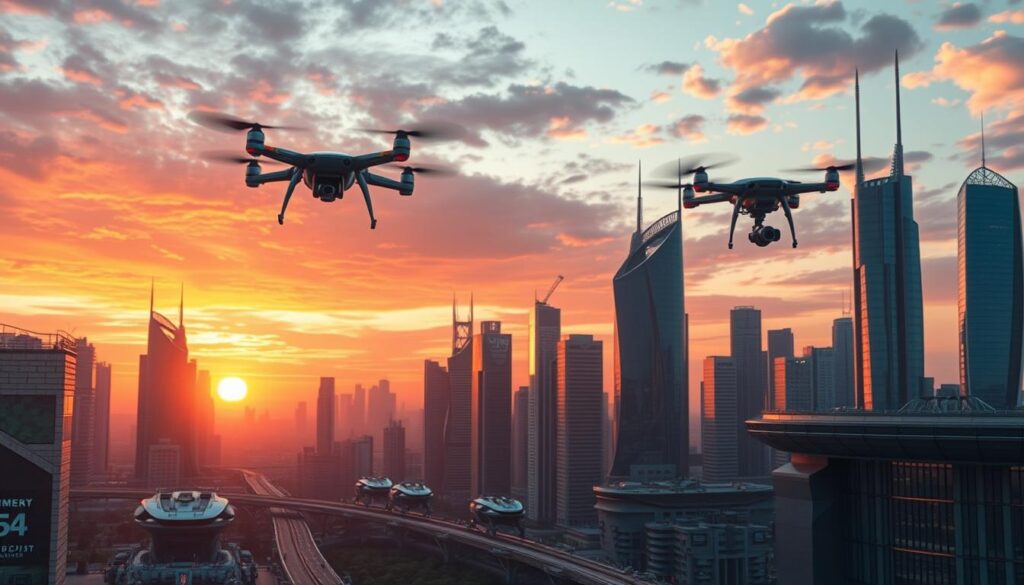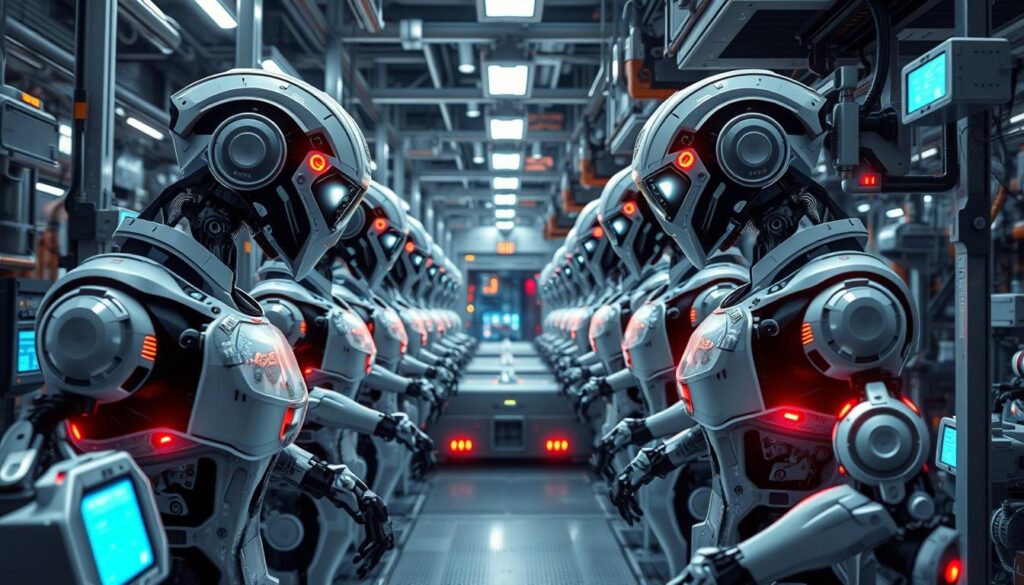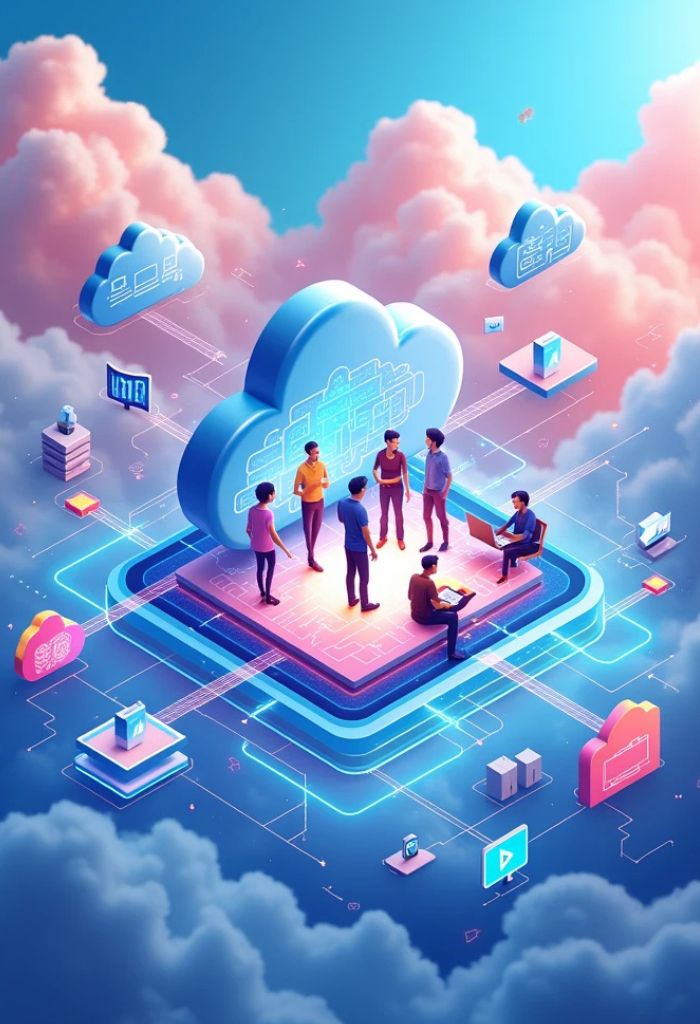Artificial Intelligence (AI) is changing our world fast. It’s making big changes in how we live and work. As “Artificial Intelligence: A Guide to Intelligent Systems” by Michael Negnevitsky shows, AI is used in many areas to make things better and more efficient.
Artificial Intelligence is making a big difference in healthcare, finance, transportation, and even our personal lives. The book “Artificial Intelligence: Revolutionizing the Future” by Stuart Russell and Peter Norvig, along with Klaus Schwab’s “The Fourth Industrial Revolution,” highlights AI’s role. It’s clear that AI is shaping our present and future.
Key Takeaways
- Artificial intelligence is redefining how industries operate.
- AI technologies drive innovation and increase efficiency.
- Healthcare, finance, and transportation are profoundly impacted.
- The future of AI holds vast potential for growth and solutions.
- Understanding AI is essential for adapting in a tech-driven world.

Understanding Artificial Intelligence
Artificial Intelligence, or AI, is a wide range of technologies that mimic human intelligence. The definition of AI has grown more complex over time. It now plays a big role in our daily lives. AI systems can do tasks that need human-like thinking, like learning and solving problems.
Artificial Intelligence is mainly split into two types of AI: weak AI and strong AI. Weak AI, or narrow AI, is made for specific tasks and works within certain limits. Examples include virtual assistants like Siri or Alexa. Strong Artificial Intelligence, however, aims to understand, learn, and apply knowledge in many ways, like humans do. This type is seen as a big step forward for technology.
AI’s wide range of applications is impressive. In healthcare, AI helps doctors diagnose better. In finance, it predicts market trends. AI also powers autonomous vehicles, personalized marketing, and smart home devices. This shows AI’s big impact on many parts of our lives.
The Evolution of AI Technologies
The history of Artificial Intelligence is a thrilling journey filled with key moments. It started in the mid-20th century with pioneers like Alan Turing. They introduced ideas that sparked interest in machine intelligence.
In the early days, Artificial Intelligence used rule-based systems to try to think like humans. These systems were not very useful but were a start. The 1980s brought neural networks, which let machines learn from data. This was a big step forward from the old systems.
The 2000s were all about machine learning. This allowed computers to get better with practice. New algorithms and lots of data made Artificial Intelligence systems smarter at finding patterns.
The last decade has seen huge leaps in AI, like deep learning and natural language processing. These advancements have changed healthcare, finance, and entertainment. They show how Artificial Intelligence is changing our lives.
Looking at AI’s history, we see not just technical progress but also a shift in how we view machines. This journey is set to bring even more exciting changes soon.
| Year | Milestone | Description |
|---|---|---|
| 1950 | Turing Test | Alan Turing introduces a test for machine intelligence. |
| 1956 | Dartmouth Conference | Considered the birth of artificial intelligence as a field. |
| 1986 | Neural Networks | Re-discovery and application of backpropagation in computing. |
| 1997 | Deep Blue | IBM’s chess computer defeats world champion Garry Kasparov. |
| 2012 | ImageNet Competition | Deep learning systems outperform traditional methods in image recognition. |
| 2020 | GPT-3 Launch | OpenAI introduces a language model that generates human-like text. |
How Machine Learning is Transforming Industries
Machine learning is a key part of the Artificial Intelligence transformation in many fields. It helps make operations better, decisions smarter, and customer service top-notch.
In healthcare, machine learning has changed how doctors diagnose. It looks at lots of medical images and patient records. This makes diagnoses more accurate, saving time and improving health outcomes.
The finance world is also seeing big changes with machine learning. It helps predict the future, spot fraud, and manage risks. By learning from past data, these systems can make better predictions, cutting down on losses and boosting profits.
Marketing has also been transformed by machine learning. Companies can now make ads that really speak to people. This targeted approach saves money and boosts sales, as ads are more likely to appeal to the right people.
| Industry | Machine Learning Application | Benefits |
|---|---|---|
| Healthcare | Diagnostics and predictive analytics | Improved accuracy and faster patient outcomes |
| Finance | Fraud detection and risk assessment | Reduced losses and enhanced profitability |
| Marketing | Consumer behavior analysis | Personalized advertising and increased conversions |
In short, machine learning is changing how industries work. It’s leading to new ways to do things better and more efficiently. As these technologies grow, they will open up even more possibilities in the AI transformation journey.
Deep Learning: The Backbone of Modern AI
Deep learning is a key part of artificial intelligence. It’s a framework that supports many AI applications. At its heart, deep learning uses neural networks, which are like the human brain.
These networks help machines learn from lots of data. They use complex algorithms and computations to do this.
Neural networks are the core of AI. They help systems recognize patterns and make choices. They’re great at tasks like image and speech recognition.
Deep learning has changed how machines understand images and sounds. This has made these tasks much more accurate.
Deep learning uses many layers of neurons. This makes a strong model that can learn data in different ways. This is what makes deep learning different from traditional machine learning.
- Versatility: Works in many areas, like healthcare and finance.
- Adaptability: Gets better with more data.
- Efficiency: Works well with big datasets, finding important insights.
In short, deep learning changes Artificial Intelligence by using neural networks. Knowing about this helps us understand AI better. It also gets us ready for new AI innovations.
| Feature | Deep Learning | Traditional Machine Learning |
|---|---|---|
| Data Handling | Handles big datasets well | Struggles with large data |
| Learning Process | Learned in layers | Needs data to be prepared |
| Performance | Very accurate for hard tasks | May not get complex patterns |
Exploring Neural Networks and Their Applications
Neural networks are key to Artificial Intelligence, working like our brains to handle information. They have layers of nodes, or neurons, that work together. This setup makes them great at many AI tasks, making things more efficient and accurate.
Speech recognition is a big area where AI shines. Virtual assistants use neural networks to understand spoken words. This lets humans and machines talk smoothly, getting better with time.
Image classification is another area where neural networks excel. They can quickly spot objects in images. This is crucial in healthcare, helping doctors diagnose with AI tools.
Autonomous systems, like self-driving cars and drones, also rely on neural networks. They use data from sensors and cameras to navigate safely. This lets them handle complex situations.
The table below shows some key uses of neural networks in different fields:
| Application Area | Description | Examples |
|---|---|---|
| Speech Recognition | Translates spoken language into text using complex algorithms. | Siri, Google Assistant |
| Image Classification | Identifies and classifies images based on learned patterns. | Medical imaging, security surveillance |
| Autonomous Systems | Enables machines to understand and interact with their environment. | Self-driving cars, delivery drones |
| Natural Language Processing | Facilitates human-like interaction and understanding of language. | Chatbots, translation services |
In conclusion, neural networks are very versatile in Artificial Intelligence. They keep improving, expanding what AI can do in many areas.
Natural Language Processing: Bridging Human and Machine Communication
Natural language processing (NLP) is key in AI communication. It lets machines understand and respond to human language. This tech uses advanced algorithms to improve how humans and computers talk to each other.

- Chatbots: These virtual helpers use NLP to offer quick support. They answer customer questions and make interactions smoother.
- Translation services: NLP helps machine translation tools. They accurately translate languages, breaking down language barriers and boosting global communication.
- Sentiment analysis: This NLP application reads emotions in text. It helps businesses understand what customers think, improving customer happiness.
NLP is getting better with AI’s growth. It makes technology easier to use and understand. The mix of AI and NLP will change how we interact with computers a lot.
Computer Vision: Enabling Machines to See
Computer vision is a big step forward in technology. It lets machines understand images and videos like we do. This field uses image processing to get important info from pictures and videos. As AI grows, computer vision becomes more important in many areas.
Autonomous vehicles are a key example. They use computer vision to see objects, measure distances, and drive safely. With advanced algorithms, they can understand what’s happening around them in real time. This makes driving safer and more efficient.
Facial recognition systems also rely on computer vision. They’re used a lot in security and to check who you are. By carefully looking at your face, these systems can quickly tell who you are and let you in.
In medicine, computer vision helps doctors make better diagnoses. Medical imaging like X-rays and MRIs are analyzed with computer vision. AI helps doctors spot things they might miss, improving health care.
| Application | Description | Benefits |
|---|---|---|
| Autonomous Vehicles | Use cameras to interpret surroundings and navigate. | Increased safety, reduced traffic accidents. |
| Facial Recognition | Identifies individuals by analyzing facial features. | Enhanced security and access control. |
| Medical Imaging | Analyzes medical scans for diagnostics. | Improved diagnostic accuracy and patient outcomes. |
Computer vision and AI are changing many fields. They’re making machines better at understanding what they see.
AI in Robotics: Redefining Automation
AI in robotics has opened up new automation levels in many fields. Robots now do tasks better and faster thanks to advanced algorithms. This change is big in manufacturing, logistics, and helping people.
In manufacturing, AI robots make assembly lines work better. They can handle complex tasks and even predict when they need a check-up. This means less downtime and more work done.
Delivery systems have also changed a lot with robotics. Drones and self-driving cars use AI to find their way and make quick decisions. This is especially true for online shopping, where companies like Amazon use it to make customers happier.
Robots are also helping at home and in healthcare. They have sensors and AI to help the elderly and disabled. They make daily life easier and better.

The mix of robotics and AI is changing automation a lot. As these techs get better, they will make things more efficient and productive. Soon, smart machines will be a big part of our daily lives.
| Industry | Application of Robotics | Benefits of AI Integration |
|---|---|---|
| Manufacturing | Assembly line workers | Increased efficiency, reduced downtime |
| Logistics | Autonomous delivery systems | Timely deliveries, real-time navigation |
| Healthcare | Personal assistance robots | Enhanced support, improved quality of life |
The Role of Data Science in AI Development
Data science is key to AI’s growth. It’s the base for creating and improving AI models. It helps companies make smart choices by analyzing data, leading to better work and new ideas.
It’s important to see how data science helps AI grow. Different fields use it to improve AI, from health to finance.
Data science and AI go hand in hand. Here’s a table showing how they work together:
| Data Science Component | Description | Impact on AI Development |
|---|---|---|
| Data Collection | Gathering relevant data from various sources | Sets the groundwork for model training and validation |
| Data Analysis | Examining data to uncover patterns and insights | Informs algorithm adjustments and strategy refinements |
| Data Visualization | Creating visual representations of data findings | Enhances understanding and communication of results |
| Predictive Modeling | Using data to forecast future outcomes | Improves the accuracy of AI systems in decision-making |
| Performance Measurement | Assessing the success of data-driven initiatives | Ensures AI systems evolve effectively over time |
By using these tools, companies can boost AI. This teamwork leads to smarter choices and new solutions for big problems.
Challenges and Ethical Considerations in AI
The world of artificial intelligence is changing fast. It brings big challenges of AI that we all need to face. One big worry is bias in AI systems. Even with good intentions, bias can sneak in.
This bias can cause unfair results. It can make things worse for equality and fairness in jobs, law, and loans.
Data privacy is another big issue. AI systems gather lots of personal info. This raises the chance of misuse. It’s key to use ethical AI to keep people’s privacy safe.
Also, automation affects jobs. Machines doing human tasks can lead to job loss. This worries about our economy and society. We need to focus on responsible AI to balance tech and ethics at work.
It’s vital to understand these complex challenges. This way, AI can help us in good ways. We must think carefully about ethics to avoid problems with fast tech growth.
Conclusion
Looking ahead, AI is more than just a trend; it’s changing the game in many areas. It boosts productivity and brings new ways to talk to machines. Leaders like Thomas H. Davenport say businesses need to get on board to stay ahead.
But with AI’s power comes the need to be careful. Harvard Business Review and Darrell M. West’s research show we must think about AI’s ethics. We need to talk openly about AI’s role in our world to make sure it’s good for everyone.
To move forward, we need everyone to work together. This includes tech experts, lawmakers, and the public. By working together, we can make AI better our lives without losing our values.
FAQ
What is Artificial Intelligence and how does it work?
Artificial Intelligence (AI) is when machines act like humans. They use machine learning and neural networks to understand and make decisions. This helps them learn from data.
What are the different types of Artificial Intelligence?
There are weak AI for specific tasks and strong AI for general human-like intelligence. Natural language processing and computer vision show these types in action.
How is machine learning transforming industries?
Machine learning makes processes more efficient. It helps companies make better decisions by analyzing big data. It also improves marketing and healthcare diagnostics.
What role do neural networks play in Artificial Intelligence?
Neural networks are key in deep learning. They mimic the brain to recognize patterns. This is important for tasks like image and speech recognition.
How does natural language processing impact communication?
Natural language processing (NLP) helps machines understand us. It’s used in chatbots, translation, and analyzing feelings. This makes talking to machines easier.
What are some applications of computer vision?
Computer vision is used in many areas. It helps in self-driving cars, facial recognition, and medical imaging. Machines can understand and act on visual data.
How does Artificial Intelligence contribute to robotics?
AI makes robots smarter by letting them learn and decide on their own. This is seen in manufacturing, delivery, and personal robots.
What is the significance of data science in AI?
Data science is vital for AI. It helps analyze and understand big data. This drives AI progress and supports smart decisions in many fields.
What are some challenges associated with AI?
AI faces issues like biased algorithms and data privacy. It also affects jobs. Solving these problems is key for AI to be used responsibly.
More about Artificial Intelligence



